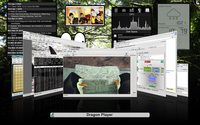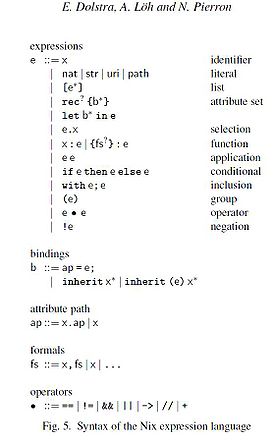NixOS: Difference between revisions
| (34 intermediate revisions by 2 users not shown) | |||
| Line 1: | Line 1: | ||
''NixOS'' is a [[:en:functional programming|functional]] Linux distribution based on the Nix package manager. It uses a functional script language to maintain the overall Linux host as which is also the basis of the package manager, in a realized solution of the Unix update problem. | '''NixOS''' is a [[:en:functional programming|functional]] Linux distribution based on the Nix package manager. It uses a functional script language to maintain the overall Linux host as which is also the basis of the package manager, in a realized solution of the Unix update problem. | ||
{{TOCleft}} | {{TOCleft}} | ||
{{Infobox OS | {{Infobox OS | ||
| Line 22: | Line 22: | ||
| website = http://nixos.org | | website = http://nixos.org | ||
}} | }} | ||
== English Wiki == | |||
[[:en:NixOS|<span style="background-color: white;">NixOS</span>]] | |||
== Organization == | == Organization == | ||
| Line 30: | Line 34: | ||
=== Relation to [[:en:Linux Standard Base|LSB]] === | === Relation to [[:en:Linux Standard Base|LSB]] === | ||
NixOS is perforce, given its basic design principles, a unique Linux system. While there are some elements of commonality with various standards and in practice there currently at this writing over 3,000 working packages showing the abstraction of "Nix" can be realized, NixOS does not conform to common layout standards such as are common to most Linux distributions. | NixOS is perforce, given its basic design principles, a unique Linux system. While there are some elements of commonality with various standards and in practice there currently at this writing are over 3,000 working packages showing the abstraction of "Nix" can be realized, NixOS does not conform to common layout standards such as are common to most Linux distributions. | ||
In particular, there is no /usr directory. | |||
=== Nix === | === Nix === | ||
Most package managers center around | Most package managers center around a file format and a set of command line and GUI frontends for managing the install of the package files. There is no such file format for Nix, the corresponding thing being the framework for capturing software configurations and the functional scripting language in which it is implemented. Command line utilities are the reference means of working with Nix packages and Nixos and there are derivative systems with GUIs. | ||
==== The Expression Language ==== | ==== The Expression Language ==== | ||
Figure 1 shows the syntax of the Nix expression | Figure 1 shows the syntax of the Nix expression language. The scripting which declaratively captures the elements of a given Nix configuration item so that it can be manipulated in operations is called that package's ''expression''<ref>[http://www.st.ewi.tudelft.nl/~dolstra/pubs/nixos-jfp-submitted.pdf ''NixOS: A Purely Functional Linux Distribution'' Dolstr and Löh]</ref> | ||
==== Package Derivation ==== | ==== Package Derivation ==== | ||
The development and maintenance of a Nix package from its author's distributed package (or the original packaging in a native Nix package) is called a ''derivation''. | |||
[[File:nix-expression-BNF.jpg|thumb|275px|left|Figure 1: [[:en:Backus-Naur form|BNF]] of the Nix Expression language]] | |||
=== Upstart === | === Upstart === | ||
NixOS uniformly uses the [[:en:Upstart|Upstart]] asynchronous, event-driven alternative to the standard Sys V initctl mechanism for management of processes as ''jobs''. | |||
== Features == | == Features == | ||
NixOS declarative configuration management approach is the basis of a number of distinctive features. | |||
===Continuous integration=== | |||
Via the Hydra subproject, NixOS supports a continuous integration build model. | |||
===Rollback=== | |||
Configuration changes whether system wide or those of a particular user can be rolled back with a single command. | |||
===User/Package Isolation=== | |||
Users have their own package managment environments, something lacking in other package managers where the user is assumed to be the superuser. | |||
== History == | == History == | ||
Latest revision as of 00:59, 21 February 2019
NixOS is a functional Linux distribution based on the Nix package manager. It uses a functional script language to maintain the overall Linux host as which is also the basis of the package manager, in a realized solution of the Unix update problem.
 Screenshot caption | |
| Company / developer | Universities of Delft and Utrecht |
| OS family | Unix-like |
| Working state | Current |
| Source model | Free and open source software |
| Initial release | MM DD, 2006 |
| Latest stable release | Rolling release |
| Update method | Package (re)Derivation |
| Package manager | Nix |
| Supported platforms | IA-32, x86-64, |
| Kernel type | Monolithic (Linux) |
| Userland | GNU |
| Default user interface | tty |
| License | GNU General Public License, others |
| Official website | http://nixos.org |
English Wiki
Organization
NixOS uses a declarative approach to 'Nix host and package managment on the bare bones of a Unix implementation. BSD and other Unices are targetted but practically Linux is the only significantly supported OS.
Relation to LSB
NixOS is perforce, given its basic design principles, a unique Linux system. While there are some elements of commonality with various standards and in practice there currently at this writing are over 3,000 working packages showing the abstraction of "Nix" can be realized, NixOS does not conform to common layout standards such as are common to most Linux distributions.
In particular, there is no /usr directory.
Nix
Most package managers center around a file format and a set of command line and GUI frontends for managing the install of the package files. There is no such file format for Nix, the corresponding thing being the framework for capturing software configurations and the functional scripting language in which it is implemented. Command line utilities are the reference means of working with Nix packages and Nixos and there are derivative systems with GUIs.
The Expression Language
Figure 1 shows the syntax of the Nix expression language. The scripting which declaratively captures the elements of a given Nix configuration item so that it can be manipulated in operations is called that package's expression[1]
Package Derivation
The development and maintenance of a Nix package from its author's distributed package (or the original packaging in a native Nix package) is called a derivation.

Upstart
NixOS uniformly uses the Upstart asynchronous, event-driven alternative to the standard Sys V initctl mechanism for management of processes as jobs.
Features
NixOS declarative configuration management approach is the basis of a number of distinctive features.
Continuous integration
Via the Hydra subproject, NixOS supports a continuous integration build model.
Rollback
Configuration changes whether system wide or those of a particular user can be rolled back with a single command.
User/Package Isolation
Users have their own package managment environments, something lacking in other package managers where the user is assumed to be the superuser.